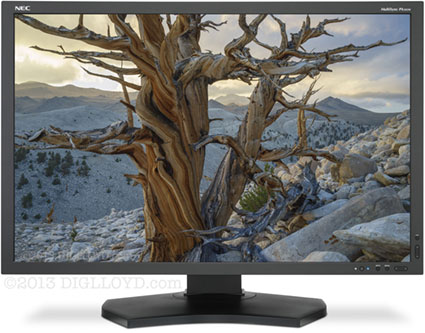Reader Question: 30-bit Color
Jonathan D writes:
Given the sorry state of Apple's current support for its professional customers, and my need right now for a powerful desktop machine with the latest and greatest processing power (both CPU and GPU), I'm on the cusp of switching platforms entirely. Sorry Apple, just can't wait any longer for your promised attention, as teasing as it is.
Regardless of operating platform or system, what's your latest take on the need and true advantage of 30-bit monitor technology, especially given great monitors like those wide-gamut NEC and Eizo offerings that feature their own 14- or 16-bit internal processing with real calibration options?
I've read opinions here and there that suggest that a proper monitor like the aforementioned easily trumps the benefits of 30-bit color, which on paper sounds so much richer, but in practice may not add enough discernible advantage in viewing our photographs, with all their texture and detail (as opposed to ramp maps), on a properly calibrated screen with deep LUTs. I know one can have both, but it looks like that becomes increasingly complicated, especially since support from Adobe is also problematic. But if it is worth the price of admission (for me, an NVidia Quattro card instead of a GeForce; I won't use AMD), I might go that route.

DIGLLOYD: my primary and workhorse display is the 2560 X 1600 NEC PA302W, which I prize for its exceptional color gamut and calibration within one delta-E. I also use the NEC PA322UHD as a second display, but mainly for viewing/reading/enjoying/palettes; that is, image evaluation is all done on the PA302W.
See my reviews of displays for photographers.
My view is that the internal 14-bit true internal calibration is most critical of all. The availability of 10-bit color is a bonus and might matter with the occasional image with subtle gradients, but I’ve found that it has made no real difference to me.
The least appealing solution is using faux calibration with an external puck has never delivered results I deemed acceptable over the built-in profiles—there are several compromised aspects (this kind of faux “calibration” is wrenching around 8-bit values in the video card, this can never be optimal particularly for dark values). It is why, for example, the Apple iMac 5K is a machine I deem unsuitable for work where color fidelity is a priority.
Faux calibration has its place, but not in my workflow! Recently I inquired as to whether 10-bit support in macOS might mean that faux calibration would use those 10 bits for 4X the precision. Unfortunately the answer is “no”. So I remain steadfast in saying that those serious about color should be looking only at true hardware calibration solutions.
When buying an NEC display, I strongly recommend buying the BK-SV model, which includes the SpectraView II software as well as the calibration hardware, for true internal calibration.
Peter G in Australia writes:
I'm trying to get my hands on an NEC PA272W in Australia and have come across this issue: https://imagescience.com.au/blog/nec-monitors-2017-update
Basically, NEC is not covering up to 8 defective pixels and apparently the rate of defective pixels is "apparently over 50% at the end of 2016" since they switched factories.
Now, I can still order one in and am tempted to do so. I figure a few dead pixels wont affect an otherwise very accurate and uniform screen.
The reseller is telling me the sensible thing would be to get the new BenQ PV270 which they say is just as good as the NEC and has a zero defective pixel warranty.
I thought I'd ask you of your thoughts since your articles convinced me the NEC was the monitor to go for!
Would you take the risk of defective pixels and stick with NEC or go with the BenQ screen?
DIGLLOYD: I forwarded this question to NEC and I’m hoping to learn something, but I am unsure if this is a worldwide policy or one that only applies to Australia.
I was not aware of any dead pixels on my {PA302W, PA301W, PA322UHD, EA244UHD, PA272W} over a period of five years. Maybe I’ve been lucky.
As for another display being “just as good”, see my comments about true internal calibration vs faux calibration further above.The NEC SpectraView II software is tried and true, which is critical.
Jereme D writes:
I’d like to clarify one thing – the BenQ is not a ‘faux’ calibration monitor – it offers proper, real, to the metal direct hardware calibration. (Also, accepts 10 but input and uses 14 bit 3D LUT tables). The direct hardware calibration system (Palette Masster) - was developed in conjunction with X-Rite and while it looks like i1Profiler on the surface, it talks directly to the monitor hardware via BenQs API for this - in the same way as SpectraView 2 (and Eizo ColorNavigator) does.
DIGLLOYD: good to know on the BenQ. Eizo is generally much more expensive here in the USA but I do like the Eizo brand—just not the cost.


























